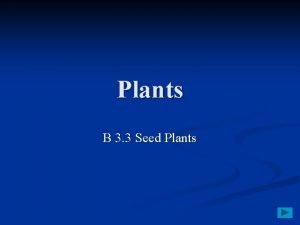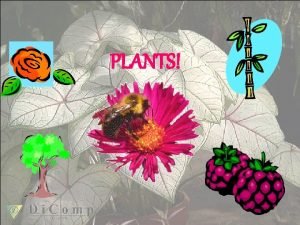The carnivourous plants Goh Jing Rong 3 E















- Slides: 15

The carnivourous plants Goh Jing Rong 3 E Wellington Primary School

The Venus flytrap (Dionaea muscipula) TRAP TYPE: Snap Trap Near the crease where the two leaf "jaws" join there is a series of tiny hairs. If an unwary insect walks across these hairs, touching two or more of them in succession, the leaf will close quickly enough to prevent its escape. Unable to escape between the hair-like teeth at the edge of the leaf, the helpless insect is slowly digested and absorbed by the leaf. Glands on the leaf surface secrete several digestive enzymes that help to decompose the insect. Once the insect has been digested sufficiently, the leaf re-opens for another victim. The mechanism of closing has fascinated biologists for many years. How can an inanimate plant react so quickly to the stimulus of touch? The most widely accepted explanation had been that a rapid change in the turgidity of the cells occurs. That is, there must be a sudden change in the water pressure in the cells – the cells of the bottom part of the midrib, that is. Now we know that it is not nearly so simple, nor is our old explanation valid, although the lower midrib cells do indeed take in more water.

Pictures of Venus flytraps A Venus flytrap about to eat the mealworm A Venus flytrap waiting for its next victim

The Pitcher plant (Nepenthes) TRAP TYPE: Pitfall Trap A native of Southeast Asia and Australia, it forms pitchers (cups) that hang from trees. Its pitcher is similar to that of the North American pitcher plant in that it relies on a pool of water to trap its prey. It has a most unusual leaf that first looks like a normal leaf, then develops a tendril at its tip, and finally the tip of the tendril develops an amazing pitcher. It gains support by twining the tendril around another plant. The trap, like our own pitcher plant, lures its prey into the pitfall trap by a combination of decaying odors and sometimes a red coloration. As the pitcher develops, it swells and droops due to its weight. As it matures, it suddenly begins inflates with air. Once inflated it begins to fill with liquid, then opens, revealing the enticing interior. The top of the trap has a lid that initially covers the pitcher until growth is complete. When the leaf is fully grown, the lid opens and the trap is ready. They attract insects with the odor of nectar. Once inside, the insect finds it cannot get a grip on the walls of the pitcher because a flaky wax on the interior surface peels off as it struggles to climb. Eventually, it falls into the water and struggles to escape. The motion caused by the struggle stimulates digestive glands to release a digestive acid. This acid is so strong that a midge will disappear within hours. The largest of these, the Rajah pitcher, is able to digest mice!

Pictures of Pitcher plants A pitcher plant about to eat a mouse! The biggest pitcher plant in the world, the Rajah pitcher plant!

The Sundew (Drosera) TRAP TYPE: Flypaper Trap The master of sticky fly paper, Drosera (sundew), is a slow trap compared to the one in Venus Flytrap. However, the sundew relies on first trapping its prey with its sticky, glandular hairs, before it slowly rolls up the edges of the leaf. It does not fold like the Venus fly trap, but it can effective enclose small flies with the numerous hairs. The sundews, so named because their glandular leaf hairs glisten like dew in the sun, are not only common in bogs, but can occur on sandy banks and other mineral soils poor in organic nitrogen and phosphorus. So fascinating is this tiny plant that Darwin (1875) spent 285 pages of his book on insectivorous plants describing his own experiments on it. The hairs are stalked glands and produce digestive juices that decompose the trapped prey. These digestive enzymes, including protease and phosphatase, increase in production once a prey has been captured, reaching maximum concentration about the fourth day. Although one sundew is hardly an effective means of eliminating insect pests, Oliver (in Heslop. Harrison, 1978) counted insects trapped in a sampling of plants in England estimated that about six million insects were trapped in a bog of about two acres!

Pictures of the Sundew A Sundew eating an insect A Sundew waiting for its next victim

The bladderwort (Utricularia) TRAP TYPE: Suction Trap Utricularia (bladderwort), a plant named for its tiny bladders, or utricles. Unlike the other carnivorous plants discussed here, Utricularia often lives in open water, but again where the nutrient concentration is relatively low. One common habitat is in the nutrient-poor bog lakes. In the open water, it supplements its nutrients by trapping insects in a bladder that is like a suction bulb. Tiny hairlike projections at the opening of the bladder are sensitive to the motion of passing organisms like Daphnia (water fleas). When they are stimulated, these hairs cause the flattened bladder to suddenly inflate, sucking in water and the passing animal and closing a trap door after it. If you ever remove a bladderwort plant from the water, you may be surprised to find audible crackling noises as the bladders get triggered shut by the motion and removal from water. Experiments indicate that growth will decrease by as much as one half if the bladders are removed. Lollar and coworkers (1971) fed labeled Crustacea (ostracods) to Utricularia and showed that radiophosphorus uptake was greater in plants with bladders than in plants without bladders, indicating that prey phosphorus is absorbed by the plant. Those hair-like structures at the opening provide a nice habitat for a group of tiny rotifers, or wheel nanimals (Figure 3). These miniature organisms have two circles of cilia at their upper end, and they rotate these cilia in such a way that it looks kike two wheels spinning toward each other. The result is that the rotifer is able to grab small particles and organisms nearby and direct them toward its mouth. By sitting near the mouth of the bladder, they can take advantage of the current when the bladder closes and grab food particles from the inflow water.

Pictures of the Bladderwort A floating bladderwort plant A bladderwort flower

The butterwort (Pinguicula) TRAP TYPE: Flypaper Trap Although butterworts have leaves and therefore trapping mechanisms that look nothing like those of the bladderworts (Utricularia), the two belong to the same family (Lentibulariaceae). Pinguicula bears one or two flowers at the end of a long stalk. The leaves of Pinguicular lutea, seen up close, bear short hairs, (seen at the base of the lower leaf) which secrete sticky mucilage. Invisible in the shiny surface of the picture are tiny round glad hairs that digest insects that are caught in the mucilage. The leaves of Pinguicula are yellowish in color, which is probably the source of the common name butterwort. The trapping mechanism of Pinguicula is a simple one. Insects become stuck in the sticky mucilage (which they may mistake for water or nectar). When an insect becomes stuck on the mucilage, the edge of the leaf slowly rolls over. The leaves never completely close. When the insect is digested, the leaf edges unroll and the leaf becomes more nearly flat. The flowers of Pinguicula lutea are bright yellow. This color is attractive to bees. A bee could fit easily into the wider part of the flower of Pinguicula lutea. There is a small pointed tip on the flower, the spur (at left), which contains a droplet of nectar. A bee, properly oriented within the flower, could feed on the nectar if it has a long tongue.

Pictures of the Butterwort A butterwort about to eat the houseflies A butterwort about to eat the moth

The cobra lily (Darlingtonia californica) TRAP TYPE: Pitfall Trap Darlintonia californica grows along stream sides and in bogs in northern California and adjacent parts of Oregon. Although the distribution of Darlingtonia is somewhat similar to the distribution of serpentine rocks in these areas, they aren't identical at all. Darlingtonia doesn't appear restricted to the serpentine sites, but it does appear to grow well in areas rich in heavy metals. The leaf of Darlingtonia is unique: it is tubular, and contains a fluid that digests trapped insects. The upper part of the leaf, is modified for the trapping function. The end of the leaf is hooded. There is a circular opening through which insects can fly into the hood. If you look closely you can see the opening. So why would they do so? One reason: on the two flag-like structures, there are glands that secrete sugary nectar, such as flies and other insects like to feed on. There are more nectar glands inside the hood, so an insect tends to progress right into the hood. Leaves of Darlingtonia often turn reddish-purple. This is a color that tends to attract flies and may aid in leading them to the leaves. Notice also that the hood has translucent areas in it, especially near the top of the hood. These have a clever purpose.

Pictures of the Cobra lily The cobra lily waiting for its next victim The cobra lily eating its prey

Sites Botany. org Bing

Thank you!




























